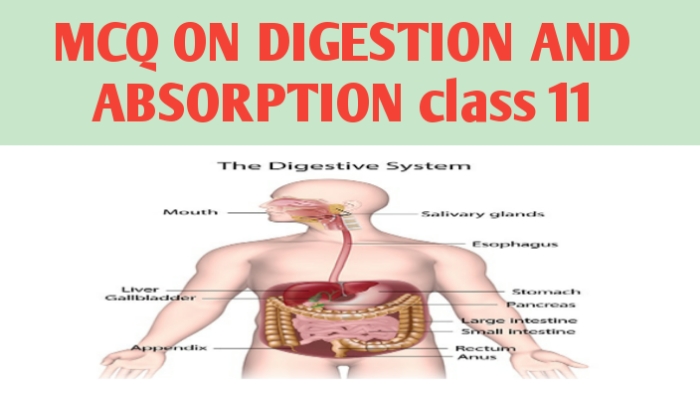MCQ ON DIGESTION AND ABSORPTION class 11 for NEET | DIGESTION AND ABSORPTION class 11 | MCQ DIGESTION AND ABSORPTION with Answer | Check the below NCERT MCQ question for class 11 Biology chapter 16 based on the DIGESTION AND ABSORPTION with Answers.

MCQ ON DIGESTION AND ABSORPTION class 11
MCQ on DIGESTION AND ABSORPTION class 11 Biology with answers were prepared based on the latest pattern.We have provided class 11 Biology MCQs questions on DIGESTION AND ABSORPTION with Answers to help students understand the concept very well.
MCQ DIGESTION AND ABSORPTION is useful for NEET / CSIR / UGC / CBSE / ICSE / AIIMS / EXAM / AFMC EXAM / STATE LEVEL MEDICAL EXAM 2022-23
Introduction:-
Food is one of the best requirements of all living organisms.The major components of our food are carbohydrates , proteins and fats.Vitamins and minerals are also required in small quantities.Food provides energy and organic materials for growth and repair of tissues.The water , we take in , play an important role in metabolic processes and also prevents dehydration of the body.Biomolecules in good can not be broken down and converted into simple substances in the digestive system.
MCQ ON DIGESTION AND ABSORPTION class 11 for NEET
1. The process of conversion of complex food substances to simple absorbable forms is called
(a) respiration
(b) digestion
(c) excretion
(d) circulation
Ans (b) digestion
2. The opening of the stomach into the duodenum is guarded by the
(a) pyloric sphincter
(b) ileum sphincter
(c) fundic sphincter
(d) all the above
Ans. (a) pyloric sphincter
3. A narrow finger like tubular projection the vermiform appendix which is
(a) homologous organ
(b) vestigial organs
(c) analogous organs
(d) all the above
Ans. (b) vestigial organs
4. The wall of alimentary canal from oesophagus to rectum possesses howmany layers?
(a) 4
(b) 3
(c) 2
(d) 1
Ans.(a) 4
5.The innermost layer linning the lumen of the alimentary canal is the
(a) submucosa
(b) mucosa
(c) serosa
(d) muscularis
Ans.(b) mucosa
ALSO READ:-
● YOU CAN WATCH BIOLOGY SIR Youtube channel
6. Crypts of Lieberkuhn is related to
(a) liver
(b) small intestine
(c) stomach
(d) all the above
Ans.(b) small intestine
7. The largest gland of the body is
(a) small intestine
(b) liver
(c) parotid
(d) thyroid
Ans.(b) liver
8. The GLISSONIS capsule is found in
(a) small intestine
(b) liver
(c) stomach
(d) large intestine
Ans.(b) liver
9. The bile duct and the pancreatic duct open together into the duodenum as the common hepato – pancreatic duct which is guarded by a sphincter called the
(a) pyloric sphincter
(b) sphincter of lumen
(c) sphincter of intestine
(d) sphincter of oddi.
Ans. (d) sphincter of oddi
10. The liver is situated in the abdominal cavity , just below the diaphragm and has …..lobes
(a) 3
(b) 2
(c) 4
(d) 1
Ans. (b) 2
11. The Saliva secreted into the oral cavity contains
(a) electrolyte
(b) enzymes
(c) salivary amylase , lysozyme
(d) all the above
Ans.(d) all the above
12. The chemical process of digestion is initiated in the oral cavity by the hydrolytic actions of the carbohydrate splitting enzyme,
(a) salivary amylase
(b) trypsin
(c) pepsin
(d) insulin
Ans.(a) Salivary amylase
13. The mucus of stomach has gastric glands.Gastric glands have major types of cells named
(a) mucus neck cells
(b) peptic cells
(c) oxyntic cells
(d) All the above
Ans. (d) all the above
14. Succus entericus is
(a) goblet cells
(b) intestinal juice
(c) liver
(d) stomach
Ans.(b) intestinal juice
15. Jejunum and ileum are parts of
(a) large intestine
(b) liver
(c) small intestine
(d) stomach
Ans. (c) small intestine
16. The absorbed substancs finally reach the tissue which utilise them for their activities.This process is called
(a) absorption
(b) assimilation
(c) digestion
(d) respiration
Ans.(b) assimilation
17. The activities of the gastro – intestinal tracts are under control of
(a) hormonal
(b) neural
(c) both a and b
(d) none
Ans.(c) both a and b
18. The complete digestionof carbohydrates, fats and proteins takes place in
(a) large intestine
(b) small intestine
(c) liver
(d) stomach
And.(b) small intestine
19.The maximum absorption of digested food takes place in
(a). Stomach
(b) liver
(c) large intestine
(d) small intestine
Ans. (d) small intestine
20. The jaundice, vomiting, diarrhoea , constipation are related to disorders
(a) disorders of digestive system
(b) disorders of respiratory system
(c) disorders of the excretory system
(d) disorders of nervous system
Ans.(a) disorders of digestive system
21.The enzyme in the pancreatic juice acts on nucleic acids to form nucleotides and nucleosides
(a) lipases
(b) nucleases
(c) trypsin
(d) All the above
Ans. (b) nucleases







Leave a Comment